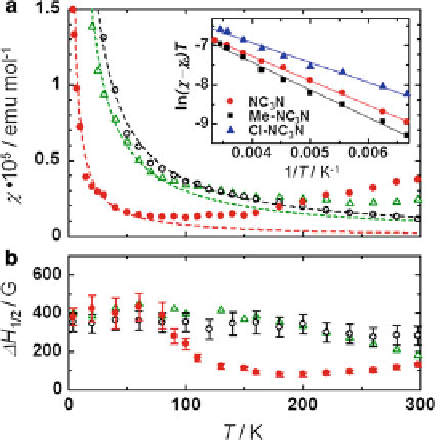Chemistry Reference
In-Depth Information
Fig. 10.14 Temperature dependence of (a) spin susceptibility (
w
) and (b) ESR linewidth (
D
H
1/2
)
obtained for the initial (
open circles
), dehydrated (
solid circles
), and rehydrated (
open triangles
)
samples of K
2
(NC
3
N)[Pt
2
(pop)
4
I]
4H
2
O. The
dashed curves
in (a) represent the fitting by the
Curie law. The inset in (a) shows the plot of
vs.
T
1
obtained for the three dehydrated salts of
K
2
(NC
3
N)[Pt
2
(pop)
4
I] (
circles
), K
2
(Me-NC
3
N)[Pt
2
(pop)
4
I] (
rectangles
), and K
2
(Cl-NC
3
N)
[Pt
2
(pop)
4
I] (
triangles
). The
solid lines
show the fitting by the activation formula
D
w
Τ
The temperature dependence of the molar spin susceptibility (
w
)ofK
2
(NC
3
N)
[Pt
2
(pop)
4
I]
4H
2
O and K
2
(NC
3
N)[Pt
2
(pop)
4
I] obtained by using ESR spectroscopy
(Fig.
10.14
) indicates the interesting electronic state in the dehydrated state
[
46
,
53
]. Although the
4H
2
O followed the Curie law
(dashed line), which is consistent with the nonmagnetic ACP + CDW state, the
w
of K
2
(NC
3
N)[Pt
2
(pop)
4
I]
of
K
2
(NC
3
N)[Pt
2
(pop)
4
I] gradually increased above about 80 K, and followed the
Curie law (dashed line) below about 80 K. The principal
g
values were determined
from the single-crystal rotation measurements at room temperature to reveal the
origin of the spin [
53
]. As a result, the anisotropic
g
value of uniaxial type with the
principal values of
g
//
¼
w
2.147 for the parallel and perpendicular
directions to the chain, respectively, were observed in the dehydrated state.
Observed anisotropy of
g
⊥
>
1.966 and
g
⊥
¼
2
> g
//
is consistent with that expected for the low-
spin Pt
3+
(
S ¼
1/2), where the unpaired electron resides on the Pt
ð
5d
z
2
Þ
orbital.
The resultant susceptibility (
D
w ¼ w
-
w
c
), where
w
c
is Curie component, obeyed
an activation type equation above about 80 K:
D
wT ¼ C
exp(-
E
g
/
k
B
T
), where
C
is
the Curie constant of activated spins,
E
g
is the activation energy, and
k
B
is the
Boltzmann constant. Concomitantly, the ESR linewidth (
D
H
1/2
) exhibited distinct
motional narrowing above the same temperature range as the spin excitation took
place, suggesting that the activated Pt
3+
spins are mobile solitons generated in the
doubly degenerated CDW state with small
d
(Pt-I-Pt). The origin of solitons are

Search WWH ::

Custom Search